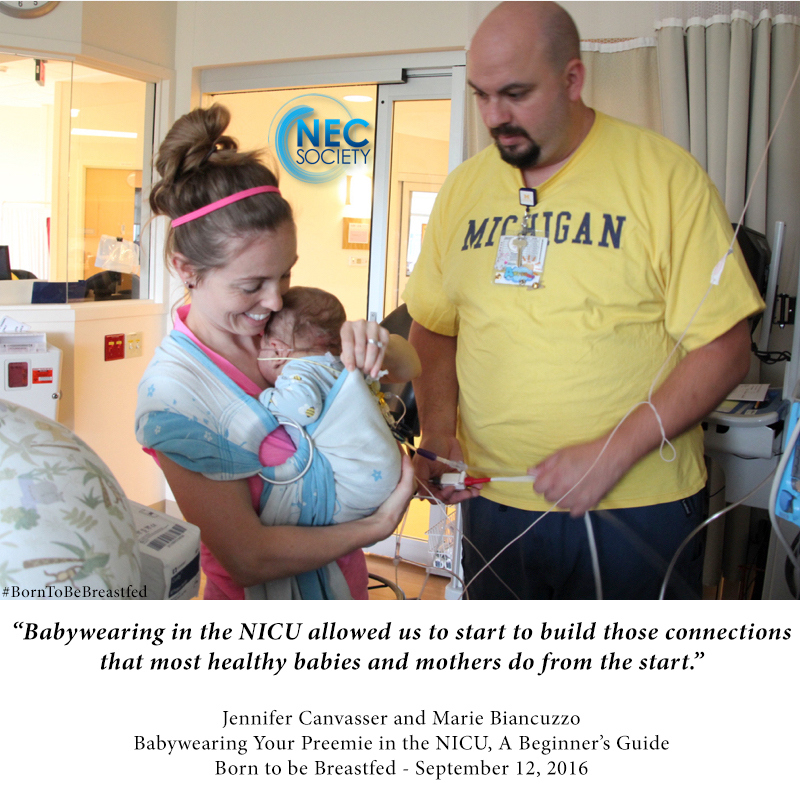 Babywearing isn’t just a fad. For some women, it’s a life-changing event. And, although babywearing has become popular among parents of full-term infants, it’s possible for parents of preterm infants to do babywearing, too.
Babywearing isn’t just a fad. For some women, it’s a life-changing event. And, although babywearing has become popular among parents of full-term infants, it’s possible for parents of preterm infants to do babywearing, too.
Often, though, premature babies are in the NICU for weeks or months. The NICU has lots of rules and routines, and babywearing isn’t one of them. Parents and professionals are unlikely to have babywearing on their to-do list. Yet, with a little pre-planning and determination, any parent can do babywearing in the NICU. Here’s how.
Often, though, premature babies are in the NICU for weeks or months. The NICU has lots of rules and routines, and babywearing isn’t one of them. Yet, with a little pre-planning and determination, any parent can do babywearing in the NICU. Here’s how.
1. Be patient. The baby might not be ready for babywearing.
For many premature babies, wearing the baby is not immediately possible. Each baby has his own capabilities and limitations; physical stability is always the goal, and, early on, it’s often achieved though kangaroo mother care. Babywearing usually occurs much later.
We don’t have any studies to show how soon parents can wear a preterm baby. Yet, as I talked with my guest, Jennifer Canvasser, on an episode of Born to Be Breastfed it seemed to me that there are a few reasonable “eligibility” criteria for babywearing. These include when the baby:
- is off the ventilator, and generally stable and predictable.
- has stabilized breathing; extended periods of non-breathing or difficult breathing no longer occur
- can be easily moved and carried.
- has central, PICC, other lines or EKG leads that are secured and protected.
Even when the baby isn’t ready for babywearing, parents can—and should—begin learning about babywearing so they will be ready later.
2. Choose the right type of carrier(s) for the circumstances
There are basically four types of baby carriers: Soft structured carrier, meh dai, woven wrap, and ring-sling (“sling”).
Each parent, as well as each baby, may be a better “fit” for one type of carrier versus another. Often, the mother may prefer one type, while the father prefers another. Similarly, in the case of twins, a carrier that works well for the bigger, stronger twin may not work well for the smaller, weaker twin.
While the parents are waiting for the baby to become “eligible” for babywearing, they can become familiar with the different types of carriers and learn how to use one or more. Most parents find it easiest to start with a ring-sling, but they should feel free to experiment with all types until they find the one that works best for the situation.
3. Practice before doing the real thing.
Jennifer explained that she practiced by wrapping herself with a teddy bear many, many times before she did so with her son. This gave her confidence, and it helped the nursing staff to see that she would be able to do wear her baby safely.
4. When will the parent be ready for babywearing?
If I were the nurse in the situation, I would tend to be overly cautious. However, if I could be convinced it was safe, I’d be the first to encourage a parent to wear the baby. The question is, how can the nurse be convinced?
First, parents and professionals need to have a good rapport. The parents need to have confidence that the healthcare team supports their need to be involved in their baby’s care in this way. The professional might want to pursue education to be sure that the parent can foster safety.
The parents need to demonstrate an ability to safely wrap the baby, and also protect the baby’s leads, lines, wires, cords, and medical devices—and have a rudimentary understanding of distress signals on the monitor or from the baby. Another important skill would be knowing how to keep the baby’s airway open and unobstructed while he is being worn.
5. Find help.
There are many resources to help with babywearing. Sometimes, a friend who has done it herself might be all that a new mother needs to at least get started. Instructional videos on YouTube, while helpful, most often address babywearing for singletons. Parents of twins will often need to tweak their technique. The next step might be finding a certified babywearing expert, and practicing how to do it. There are also groups that meet online, or groups that meet within the community.
Babywearing isn’t necessarily something you can do immediately or intuitively, but with a little patience, becoming familiar with your baby’s situation and with the professionals who are caring for him, and knowing how to practice the techniques and use the available resources, any parent can find enjoy this great experience.
Have you already had any experience with babywearing?
Would you like to learn more? Earn 1.5 L-CERPs and/or 1.5 Contact Hours with our self-learning program, “Babywearing in the NICU for Preterm Infants.” Click here to purchase.

Pingback:The 8 Best Baby Carrier For Preemies Or Small Babies 2021